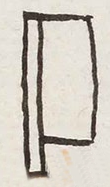panitl (Mdz55r)
This element for panitl or pamitl (flag, banner) has been carved from the compound sign for the place name, Oxitipan. The flag is white, as is the pole. The pole is on the left. The height of the flag is at least twice its width.
Stephanie Wood
In the context from which it was taken, the flag was serving to provide the phonetic value for the locative suffix -pan. Because there is no absolutive on the pan, it is conjecture that panitl is the source. We are watching for the use of pantli, tecpantli, panitl, and pamitl. It is a challenge to differentiate between them, for they look very much alike most of the time. For now, when the banner has an association with a number, we are using pantli or tecpantli, watching how they are glossed, and when it is a phonetic locative for a place name, we are often using panitl. Apparently panitl was more common in "Mexico, the Tepanec heartland, and perhaps Colhuacan and Chalco," and pamitl in "northern and eastern flanks of the Valley of Mexico" [see: Jorge Klor de Alva, in The Work of Bernardino de Sahagún: Pioneer Ethnographer of Sixteenth-century Aztec Mexico (Albany, NY: Institute for Mesoamerican Studies, the University at Albany, State University of New York, 1988), 323]. As glyphs come in to this collection from regions where pamitl is more common, we will abide by that orthography.
Stephanie Wood
c. 1541, or by 1553 at the latest
Stephanie Wood
flags, banners, banderas, pantli, pamitl

pani(tl), flag or banner, https://nahuatl.wired-humanities.org/content/panitl
-pan (locative suffix), https://nahuatl.wired-humanities.org/content/pan
la bandera
Stephanie Wood
Codex Mendoza, folio 55 recto, https://digital.bodleian.ox.ac.uk/objects/2fea788e-2aa2-4f08-b6d9-648c00..., image 116 out of 188.
The Bodleian Libraries, University of Oxford, hold the original manuscript, the MS. Arch. Selden. A. 1. This image is published here under the UK Creative Commons, “Attribution-NonCommercial-ShareAlike 3.0 License” (CC-BY-NC-SA 3.0).

